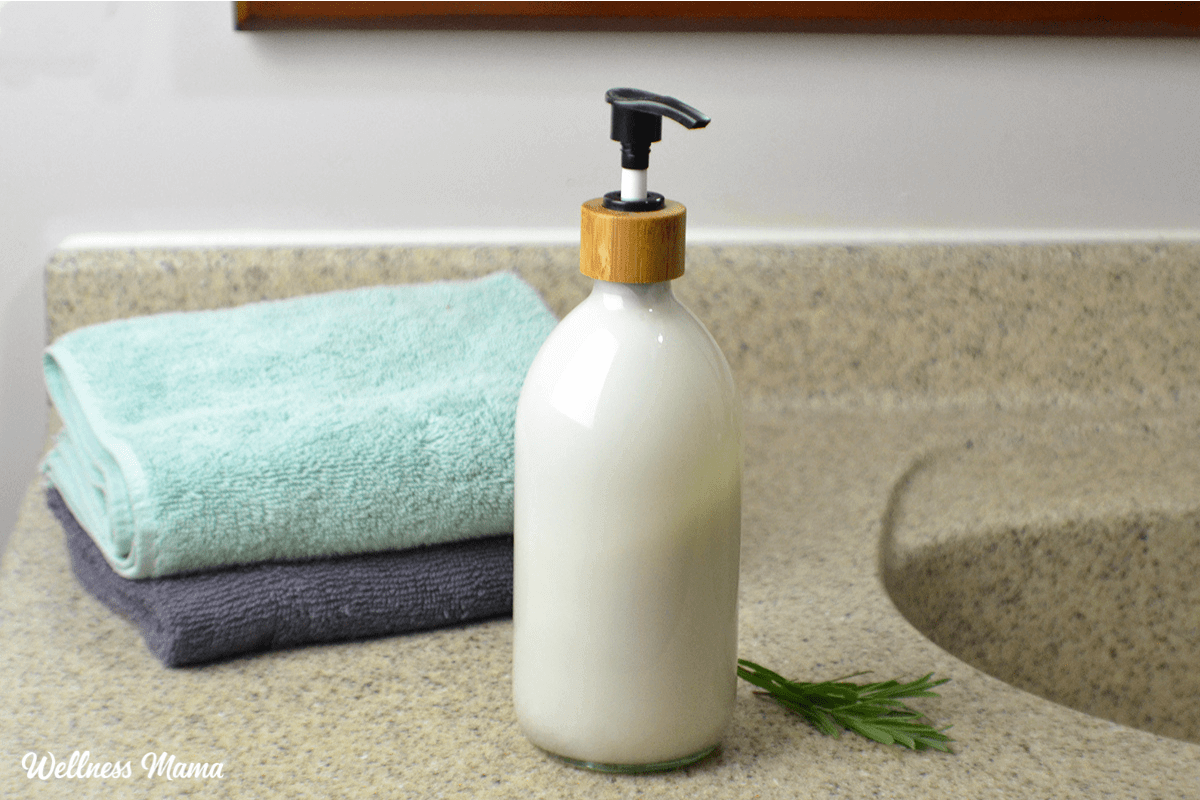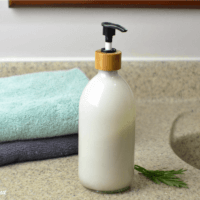There are a lot of options when it comes to hair conditioner, even natural conditioners. While I like using this deep conditioning molasses hair mask, it’s nice to have something simple for everyday use on hand. This homemade conditioner is simple, convenient, and moisturizes dry hair naturally.
What Does Conditioner Do?
Before we start making our own conditioner it helps to understand what’s happening here. Our hair follicles make sebum which is moisturizing and repairing to damaged hair and split ends. Too much sebum though and we get that greasy hair look.
Some people are able to get by with water washing their hair or baking soda, but the majority of us rely on shampoo. While shampoo is necessary to keep the hair and scalp clean, it also strips it of necessary oils. Conditioner helps add these back in.
The Best Way to Condition Hair
Here are some tips for getting the most out of your natural conditioner:
- Focus on the ends of the hair. Adding too much to the scalp can make hair look greasy. Remember, the scalp is where sebum is made but it can have a hard time getting to hair ends.
- Apply generously and leave on for a few minutes before rinsing. This gives the conditioner time to work its magic.
- Condition more than you shampoo, especially with textured and curly hair. Shampooing too much isn’t healthy for hair which is why I don’t shampoo every day. A good DIY conditioner though can help keep hair healthy and strong through the week.
Choosing a Good Natural Conditioner
Anyone who has ever walked into the shampoo aisle at the local big box store knows just how many conditioner options there are. And that’s not even counting all of the ones sold online or in specialty stores. Even the homemade conditioner options can be overwhelming.
Typical store bought conditioner has a thick, lotiony consistency. Homemade conditioners can range from apple cider vinegar to coconut oil, to smearing mashed avocado on your tresses. While none of these DIY options are bad, they’re not as easy or shelf stable. Avocados don’t last a week on my counter before going brown, they’re sure not going to last as a conditioner in my bathroom.
Certain ingredients like aloe vera and shea butter are good for hair, but they’re hard to incorporate into a homemade hair conditioner recipe. Some homemade options can cause buildup on the hair cuticles, making hair feel greasy. If you need something to help with product buildup on the scalp, then try a DIY scalp scrub.
While I use coconut milk in my homemade shampoo, its short shelf life and fickleness are why it isn’t in this natural hair conditioner.
Homemade Natural Conditioner
I wanted to create a recipe that didn’t need replacing every few days or made up on the spot. I wanted something that would stick to hair for a bit and work on the strands, so not an herbal hair rinse. Most importantly, I wanted something that was simple yet still worked.
Customizing Your DIY Conditioner
We obviously don’t all have the same hair. Thin hair needs different treatment than thick or textured hair. This recipe can be customized so it meets your specific hair needs. It may take a little tweaking to find your perfect recipe, but the template is the same. First let’s get into the ingredients used, who they work for, and possible substitutions.
The Best Oils for Homemade Conditioner
Since shampoo strips the hair’s oil we need to add some back in. Just rubbing some oil into hair though can quickly get messy though… and then we’re back to overly greasy. While I like using straight up oil for a deep conditioning treatment, it’s too intense for everyday use.
This homemade conditioner uses oils in the recipe, but not too much. Which oils we choose are just as important though. Here’s a breakdown of some of my favorite hair healthy oil options to use in DIY conditioner.
Castor Oil
Castor oil is one of the best ways to grow stronger, longer, healthier hair. It’s great for the scalp and helps with hair loss, breakage, and dandruff, among other benefits. Castor oil has antioxidants that help hair to be smoother with less frizz. I use diluted castor oil as an overnight hair treatment, but it’s also an easy addition in a DIY conditioner.
This oil is thought to balance scalp pH and can help restore hair and scalp health after using harsh hair care products. Many people have seen impressive hair growth with this one.
Avocado Oil
Avocado oil makes a mean mayo, but it’s also great for hair and skin health. Saturated and monounsaturated fats, like those found in olive oil and avocado oil, sink deeper into damaged hair.
Argan Oil
Argan oil has become a bit of a trend lately, but it has a long history of use in certain cultures. Argan oil is a rare oil that isn’t as cheap as some other options, but well worth it. I like mixing some into my hair care products because a little goes a long way here.
While conventional conditioners also have other ingredients I want to avoid, it’s easy to add argan to a homemade conditioner. Argan helps repair dry, damaged hair and reduces frizzy hair. It works by smoothing the hair shafts and adds shine.
Argan oil is full of:
- Vitamins A and E
- Antioxidants
- Omega-6 fatty acids
- Linoleic acid
Jojoba Oil
Technically jojoba is a wax, not an oil. It works perfectly in hair and skincare because it closely mimics our own sebum. This helps it to moisturize without leaving an overly greasy feeling. Jojoba helps reduce frizz and is full of nutrients our hair and scalp need. You’ll find:
- Vitamin E
- B-complex vitamins
- Zinc
- Copper
- Selenium
- Chromium
- Iodine
Coconut Oil
While coconut oil is really popular, it’s actually not my favorite for hair. Because coconut oil helps the hair hold onto protein better, it doesn’t work for all hair types. Some people find it very drying and it makes their hair brittle.
Then there’s the issue of temperature. Virgin coconut oil is solid at room temp, but starts to melt when the temperature rises. You may find that certain DIY products become rock solid in winter and too drippy in summer with coconut oil.
That said, if you have finer hair and want to add in some healthy coconut oil it can be done. The little bit of coconut oil added to this DIY conditioner shouldn’t be enough to really affect the consistency.
How to Make a Customized DIY Conditioner
My hair is thinner and runs on the greasy side so I don’t need to add too much oil. Those with thicker, textured, or dry hair can increase the amount of oils used. I recommend trying jojoba regardless of hair type since it so closely mimics our own sebum. The other oils can be swapped out for what you have on hand or what sounds good.
Microbes Love Water
I don’t use a lot of water in my skincare recipes because they start to grow icky stuff faster. Bacteria and fungus love moisture and homemade conditioner definitely has moisture. Because this recipe uses water it needs to be clean and microbe free. Bottled, distilled water is ideal, but boiled filtered water is the next best option. Hydrosols will also work and have a slightly longer shelf life. There are tons of different hydrosol options that work well for hair, like lavender, tea tree, or rose.
You can either use hydrosols for the entire water portion of the recipe, or just add some to your distilled water.
This recipe uses a natural broad spectrum preservative to improve the shelf life. If you want to make a new batch every week and store it in the fridge, then you could maybe skip the preservative. Just keep in mind that touching a jar of conditioner in the shower is going to be a breeding ground for microbes.
By using a pump bottle or a squeeze bottle it eliminates the touching it with your hands part. Even if you do use a preservative, I think the bottles are better options than a jar here.
The Best Natural Preservative
I used Leucidal Complete because it’s easy, readily available, and has natural ingredients. It has to be used at 2-4% to be effective, so I’ve included it at 4% here. Leucidal is ECOcert approved for certified organic products and is on the Whole Foods approved ingredients list.
Since you’re not likely to send your homemade conditioner to a lab for stability testing, we can’t know how long the shelf life is exactly. However, adding a natural preservative and following common hygiene measures (like don’t use dirty hands or leave it in a hot car) means it should last for several months at least.
Mixing It Up
A few of my DIY recipes rely on emulsifying wax. This stuff magically lets oil and water mix together to create a creamy consistency. While I love natural beeswax for candles and salves, it won’t do the job here. Emulsifying wax also helps to thicken the product.
There are several different kinds available, some more natural than others so be sure to check the product labels before buying.
Adding in Essential Oils
Essential oils are another great way to customize your conditioner, plus they smell great! For this recipe I used a blend of tea tree essential oil, rosemary essential oil, and lavender essential oil which are nourishing for hair and scalp. Here’s a more complete list of the different options and which essential oils are best for hair.
Homemade Conditioner Recipe
Materials
- ½ cup distilled water or hydrosol tea tree or lavender are good options
- 1 and ½ tsp jojoba oil
- 1 and ½ tsp argan oil or other oil of choice
- 1 tsp glycerin
- 4 tsp emulsifying wax
- 1 and ¼ tsp leucidal complete preservative
- 30 drops essential oil optional
Instructions
- Place oils, glycerin and wax in a heat safe glass bowl. Place the bowl on top of a pot filled with water to make a double boiler and bring the water to a boil.
- Stir occasionally until fully melted then remove the bowl from the heat.
- Stir in the water and/or hydrosol. Once the mixture is warm but no longer hot, stir in the Leucidal Complete and essential oils if using.
- Continue to stir frequently until the mixture has cooled to room temperature. The fridge can help speed up the process but make sure everything is well combined first.
- Transfer the conditioner to a squeeze or pump bottle and store away from sunlight and excess heat. For an even longer shelf life keep it in the fridge.
Notes
No Time to DIY?
That’s why I made my own line of natural haircare products… try my own Wellnesse Conditioner for soft, manageable hair naturally!This article was medically reviewed by Madiha Saeed, MD, a board certified family physician. As always, this is not personal medical advice and we recommend that you talk with your doctor.
How will you customize this DIY conditioner? Leave us a comment and let us know!



Leave a Reply